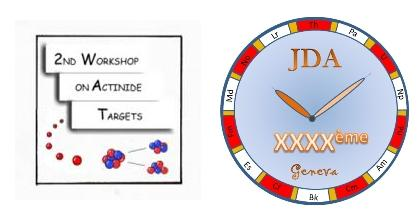Speaker
Mr
laurent CLAPAREDE
(CEA/DEN/DRCP/SCPS/LC2A)
Description
Influence of crystallization state and microstructure over chemical durability of mixed dioxides
L. Claparède 1,2, N. Clavier 2, N. Dacheux 2, R. Podor2, J. Ravaux2
P. Moisy 1 and J. Dauby 1
1 CEA/DEN/DRCP/SCPS/LCA, Site de Marcoule, BP 17171, 30207 Bagnols / Cèze, France, e-mail:
Laurent.claparede@cea.fr
2 ICSM, Site de Marcoule, BP 17171, 30207 Bagnols / Cèze, France
The reprocessing of actinides from nuclear spent fuel into new fuel elements has emerged to economise uranium resources, reduce long-term radiotoxicity of waste and increase resistance of plutonium to proliferation. Such a strategy, initiated with the recycling of uranium and plutonium into MOX fuel obtained through dry chemistry processes, could be improved by the initial co-precipitation of cations into low-temperature precursors such as oxalates. The final compounds are then expected to present a greater homogeneity in term of cations repartition as well as an improved microstructure. In this context, it appears important to evaluate the consequences of these changes over dissolution processes.
Particularly, this study aims to highlight the relationships between the crystallization state and the microstructure of dioxide materials and their ability to dissolve since several studies already shown that parameters such as density, porosity, grain size or density of grain boundaries could have a significant impact on dissolution rates [ , ]. As a first approach before the preparation of actinides mixed dioxides, model compounds with general formula Ce1-xNdxO2 were synthesized from oxalic co-precipitation then fired to obtain the corresponding oxides (300°C < T < 1100°C)
Fig 1: XRD patterns of CeO2 versus temperature of heat treatment in air.
Fig 2: Variation of the FWHM versus the temperature
Above 300°C, the XRD patterns show the characteristic diffraction lines of the face-centered cubic structure of fluorite-type CeO2 (space group Fm3m). The variation of the crystallization state of cerium dioxide with the heat treatment was evidenced through the average full width at half maximum (Fig 2).
.
In a first step, average FWHM decreases strongly between 300°C to 700°C, and then stabilized up to 1100°C. The crystallization of the cerium dioxide seems optimal from 700°C.
The dissolution of these solids was then studied in 2M HNO3 at 60°C. Whatever the temperature of the heat treatment, the variation of the normalized weight loss (NL) show two distinct tendencies. On the one hand, the evolution of the normalized mass loss is linear during the first days. On the other hand, after about 8 days of leaching, the normalized dissolution rate, Rt, decreases by an order of magnitude over R0. This result could be explained by the formation of a amorphous gelatinous layer at the surface of the solid. The variation of normalized dissolution rates R0 and Rt was then studied versus the temperature of the heat treatment (fig 3).
a) b)
Fig 3: Variation of R0 (a) and Rt (b), versus heat treatment
The initial dissolution rate decreases inversely with temperature. This result is in good agreement with the variation of the full width at half maximum of diffraction peaks. Moreover the ratio and appear nearly equal, which tends to indicate that FWHM is a good indicator to evaluate the influence of crystallization state. Conversely, the Rt value was not found to be sensitive to crystallisation state. This result could be correlated to the presence of the gel which annihilates the influence of crystallization state.
Studies are now currently underway on sintered pellets to highlight the relationships between the microstructure of dioxide materials and their dissolution.
Primary author
Mr
laurent CLAPAREDE
(CEA/DEN/DRCP/SCPS/LC2A)
Co-authors
Dr
Nicolas CLAVIER
(ICSM/LIME)
Prof.
Nicolas DACHEUX
(ICSM/LIME)




